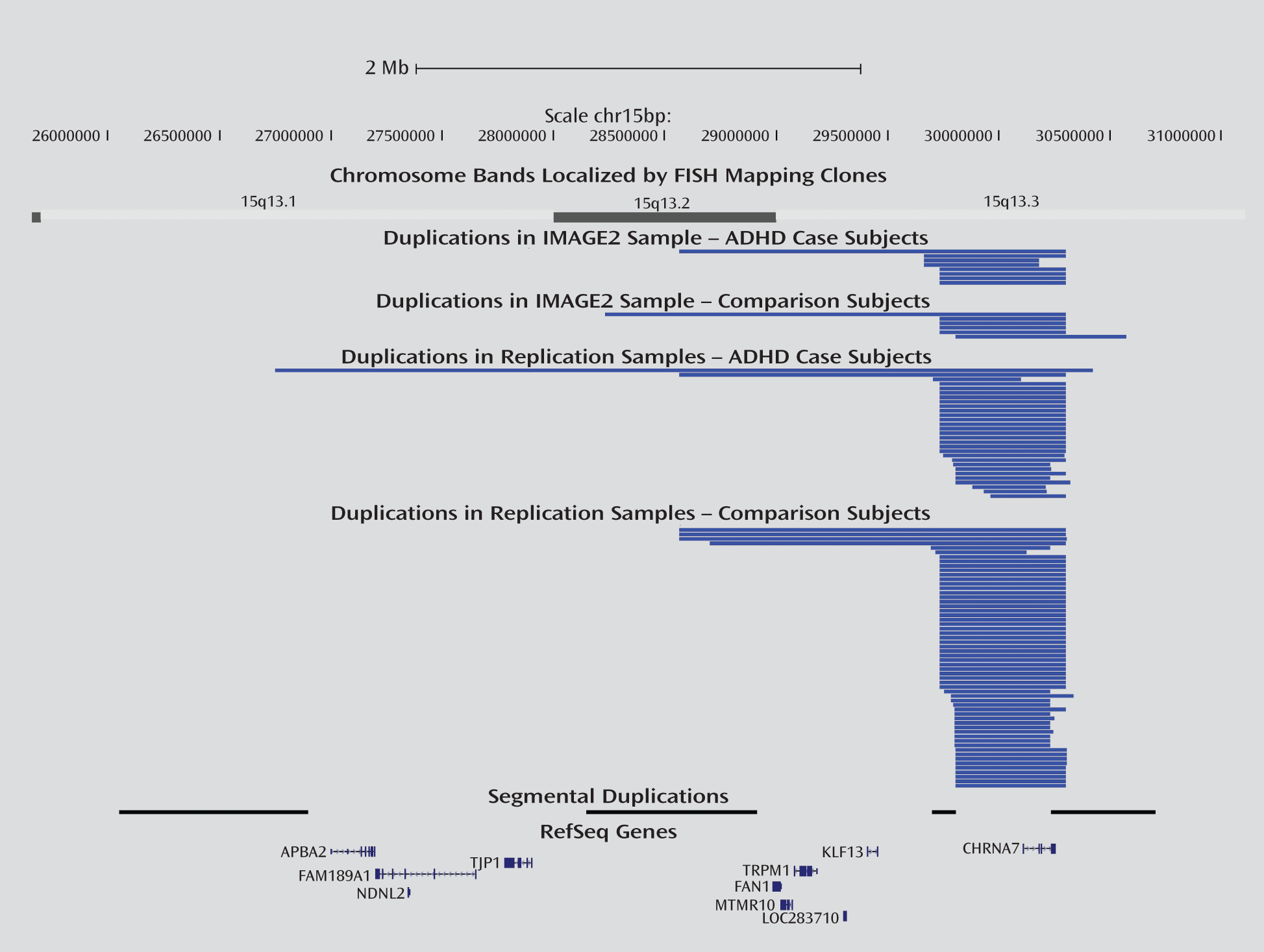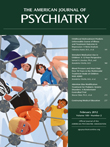Genome-Wide Analysis of Copy Number Variants in Attention Deficit Hyperactivity Disorder: The Role of Rare Variants and Duplications at 15q13.3
Abstract
Objective:
Method:
Results:
Conclusions:
Method
Participants
Statistical Analysis of Rare CNV Data
Validation of a Rare CNV on 15q13.3
Replication of Duplications at 15q13.3
Results
| Burden of CNVs | Burden of Deletions Only | Burden of Duplications Only | ||||||||||
|---|---|---|---|---|---|---|---|---|---|---|---|---|
| Measurea | ADHD Subjects | Comparison Subjects | Ratio | pb | ADHD Subjects | Comparison Subjects | Ratio | pb | ADHD Subjects | Comparison Subjects | Ratio | pb |
| CNVs >100 kb | ||||||||||||
| N | 460 | 1,102 | 161 | 406 | 299 | 696 | ||||||
| Rate | 0.628 | 0.548 | 1.15 | 0.014 | 0.220 | 0.202 | 1.09 | 0.199 | 0.409 | 0.346 | 1.18 | 0.016 |
| Proportion | 0.456 | 0.406 | 1.13 | 0.011 | 0.194 | 0.179 | 1.09 | 0.197 | 0.327 | 0.282 | 1.16 | 0.014 |
| CNVs >500 kb | ||||||||||||
| N | 89 | 191 | 22 | 47 | 67 | 144 | ||||||
| Rate | 0.122 | 0.095 | 1.28 | 0.032 | 0.030 | 0.023 | 1.29 | 0.199 | 0.092 | 0.072 | 1.28 | 0.059 |
| Proportion | 0.112 | 0.092 | 1.22 | 0.069 | 0.030 | 0.023 | 1.29 | 0.199 | 0.085 | 0.070 | 1.21 | 0.113 |
| CNVs >100 kb, intersecting genes | ||||||||||||
| N | 303 | 720 | 74 | 203 | 229 | 517 | ||||||
| Rate | 0.414 | 0.358 | 1.16 | 0.025 | 0.101 | 0.101 | 1.00 | 0.524 | 0.313 | 0.257 | 1.22 | 0.013 |
| Proportion | 0.329 | 0.290 | 1.14 | 0.031 | 0.097 | 0.092 | 1.06 | 0.359 | 0.262 | 0.219 | 1.20 | 0.010 |

| ADHD Subjects | Comparison Subjects | |||||||||
|---|---|---|---|---|---|---|---|---|---|---|
| Sample | 15q13 Duplication (N) | No Duplication (N) | Duplication Frequency (%) | 15q13 Duplication (N) | No Duplication (N) | Duplication Frequency (%) | p | Odds Ratio | 95% CI | Breslow-Day Test |
| Primary study | ||||||||||
| IMAGE II | 8 | 724 | 1.10 | 6 | 2,004 | 0.30 | 0.016 | 3.68 | 1.27–10.63 | |
| Replication studies | ||||||||||
| Cardiff | 6 | 313 | 1.92 | 5 | 1,042 | 0.48 | 0.023 | 3.99 | 1.21–13.18 | |
| Children's Hospital of Philadelphia | 15 | 998 | 1.50 | 32 | 4,073 | 0.79 | 0.039 | 1.91 | 1.03–3.55 | |
| Toronto | 2 | 245 | 0.82 | 16 | 2,341 | 0.68 | 0.814 | 1.19 | 0.27–5.23 | |
| PUWMa | 6 | 686 | 0.87 | 5 | 1,096 | 0.46 | 0.210 | 0.91 | 0.34–2.44 | |
| All replication samples | 29 | 2,242 | 1.29 | 58 | 8,552 | 0.68 | 0.00275 | 2.02 | 1.26–3.21 | 0.62 |
| All samples combined | 37 | 2,966 | 1.25 | 64 | 10,556 | 0.61 | 0.000178 | 2.22 | 1.46–3.38 | 0.28 |
| All CNVs >100 kb | |||||
|---|---|---|---|---|---|
| Gene/Locus and Measure | Chromosome | Start (bp) | End (bp) | ADHD Subjects | Comparison Subjects |
| Implicated in autism | |||||
| NRXN1 | 2 | 50000991 | 51113178 | 0 | 0 |
| SLC9A9 | 3 | 144466753 | 145049979 | 0 | 0 |
| c3orf58 | 3 | 145173602 | 145193895 | 0 | 0 |
| NIPBL | 5 | 36912617 | 37101678 | 0 | 0 |
| NSD1 | 5 | 176492685 | 176659820 | 0 | 0 |
| AHI1 | 6 | 135646816 | 135860576 | 0 | 0 |
| CNTNAP2 | 7 | 145444385 | 147749019 | 0 | 0 |
| CHD7 | 8 | 61753892 | 61942021 | 0 | 0 |
| VPS13B | 8 | 100094669 | 100958984 | 0 | 0 |
| TSC1 | 9 | 134756556 | 134809841 | 0 | 0 |
| PTEN | 10 | 89613174 | 89718512 | 0 | 0 |
| DHCR7 | 11 | 70823104 | 70837125 | 0 | 0 |
| CACNA1C | 12 | 2032676 | 2677376 | 0 | 0 |
| PTPN11 | 12 | 111340918 | 111432100 | 0 | 0 |
| UBE3A | 15 | 23133488 | 23235221 | 0 | 0 |
| TSC2 | 16 | 2037990 | 2078714 | 0 | 0 |
| CREBBP | 16 | 3715056 | 3870122 | 0 | 0 |
| RAI1 | 17 | 17525511 | 17655490 | 0 | 0 |
| NF1 | 17 | 26446120 | 26728821 | 0 | 0 |
| DMPK | 19 | 50964815 | 50977655 | 0 | 0 |
| ADSL | 22 | 39072449 | 39092521 | 0 | 0 |
| SHANK3 | 22 | 49459935 | 49518507 | 0 | 0 |
| 1p36 | 1 | 1 | 5308621 | 2 | 0 |
| 1q21.1 | 1 | 144979000 | 146204000 | 1 | 3 |
| 2q37 | 2 | 239619630 | 242951149 | 0 | 1 |
| 4p16 | 4 | 1 | 2043468 | 0 | 0 |
| 7q11.23 | 7 | 71970679 | 74254837 | 0 | 0 |
| 15q11.2–q13.1 | 15 | 21309483 | 26230781 | 2 | 1 |
| 15q13.3 | 15 | 28557287 | 30488774 | 9 | 7 |
| 15q24 | 15 | 72164227 | 73949332 | 0 | 0 |
| 16p11.2 | 16 | 29550000 | 30200000 | 1 | 4 |
| 22q11 | 22 | 17015754 | 20000000 | 3 | 4 |
| CNVs overlapping | 18 | 20 | |||
| CNVs not overlapping | 442 | 1,082 | |||
| p | 0.009 | ||||
| Frequency of CNV hits | 0.039 | 0.018 | |||
| Ratio (case/control) | 2.156 | ||||
| Implicated in schizoprenia | |||||
| CNTNAP2 | 7 | 145444385 | 147749019 | 0 | 0 |
| NRXN1 | 2 | 50000991 | 51113178 | 0 | 0 |
| 1q21.1 | 1 | 144940000 | 146290000 | 1 | 3 |
| 15q11.2 | 15 | 20310000 | 20780000 | 8 | 13 |
| 15q13.3 | 15 | 28720000 | 30300000 | 9 | 7 |
| 16p13.11 | 16 | 14890000 | 16390000 | 3 | 9 |
| 16p11.2 | 16 | 29554844 | 30085308 | 1 | 4 |
| 22q11 | 22 | 17500000 | 20000000 | 3 | 4 |
| CNVs overlapping | 25 | 40 | |||
| CNVs not overlapping | 435 | 1,062 | |||
| p | 0.03 | ||||
| Frequency of CNV hits | 0.054 | 0.036 | |||
| Ratio (case/control) | 1.497 | ||||
Discussion
Acknowledgments
Footnote
Supplementary Material
- View/Download
- 412.18 KB
References
Information & Authors
Information
Published In
History
Authors
Author Contributions
Funding Information
Metrics & Citations
Metrics
Citations
Export Citations
If you have the appropriate software installed, you can download article citation data to the citation manager of your choice. Simply select your manager software from the list below and click Download.
For more information or tips please see 'Downloading to a citation manager' in the Help menu.
View Options
View options
PDF/EPUB
View PDF/EPUBLogin options
Already a subscriber? Access your subscription through your login credentials or your institution for full access to this article.
Personal login Institutional Login Open Athens loginNot a subscriber?
PsychiatryOnline subscription options offer access to the DSM-5-TR® library, books, journals, CME, and patient resources. This all-in-one virtual library provides psychiatrists and mental health professionals with key resources for diagnosis, treatment, research, and professional development.
Need more help? PsychiatryOnline Customer Service may be reached by emailing [email protected] or by calling 800-368-5777 (in the U.S.) or 703-907-7322 (outside the U.S.).

